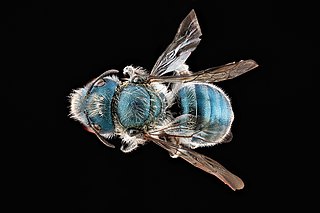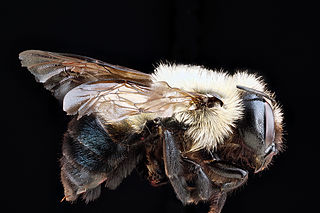
Megachilidae is a cosmopolitan family of mostly solitary bees whose pollen-carrying structure is restricted to the ventral surface of the abdomen. Megachilid genera are most commonly known as mason bees and leafcutter bees, reflecting the materials from which they build their nest cells ; a few collect plant or animal hairs and fibers, and are called carder bees, while others use plant resins in nest construction and are correspondingly called resin bees. All species feed on nectar and pollen, but a few are kleptoparasites, feeding on pollen collected by other megachilid bees. Parasitic species do not possess scopae. The motion of Megachilidae in the reproductive structures of flowers is energetic and swimming-like; this agitation releases large amounts of pollen.

Mason bee is a name now commonly used for species of bees in the genus Osmia, of the family Megachilidae. Mason bees are named for their habit of using mud or other "masonry" products in constructing their nests, which are made in naturally occurring gaps such as between cracks in stones or other small dark cavities. When available, some species preferentially use hollow stems or holes in wood made by wood-boring insects.
Osmia glauca is a species in the genus Osmia, in the family Megachilidae . It is found in North America.

Osmia chalybea is a species of bee in the family Megachilidae. It is found in North America.

Osmia simillima is a species of bee in the family Megachilidae. It is found in North America.

Osmia texana, the Texas osmia, is a species of bee in the family Megachilidae. It is found in Central America and North America.

Osmia georgica is a species of bee in the family Megachilidae. It is found in Central America and North America.

Osmia pumila is a species of bee in the family Megachilidae. It is found in Central America and North America.
Osmia cyanella is a species of bee in the family Megachilidae. It is found in North America.
Osmia dakotensis is a species of bee in the family Megachilidae. It is found in North America.
Osmia botitena is a species of bee in the family Megachilidae. It is found in North America.

Osmia distincta is a species of bee in the family Megachilidae. It is found in North America.
Osmia clarescens is a species of bee in the family Megachilidae. It is found in Central America and North America.

Osmia integra is a species of bee in the family Megachilidae. It is found in North America.
Osmia coloradensis, the Colorado osmia, is a species of bee in the family Megachilidae. It is found in Central America and North America.

Osmia taurus is a species of bee in the family Megachilidae. It is found in North America and Southern Asia.
Osmia longula is a species of bee in the family Megachilidae. It is found in North America.

Osmia bucephala, the bufflehead mason bee, is a species of bee in the family Megachilidae. It is found in North America.

Osmia subfasciata is a species of bee in the family Megachilidae. It is found in Central America and North America.

Osmia calaminthae, commonly known as the blue calamintha bee, is a rare species of mason bee known only to Highlands County, Florida, United States. It is considered Critically Imperiled by NatureServe. The common name for the bee is derived from its distinctly blue color and its favored host plant, Calamintha ashei.












